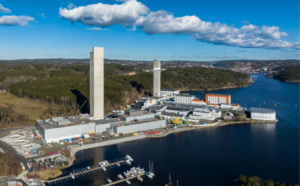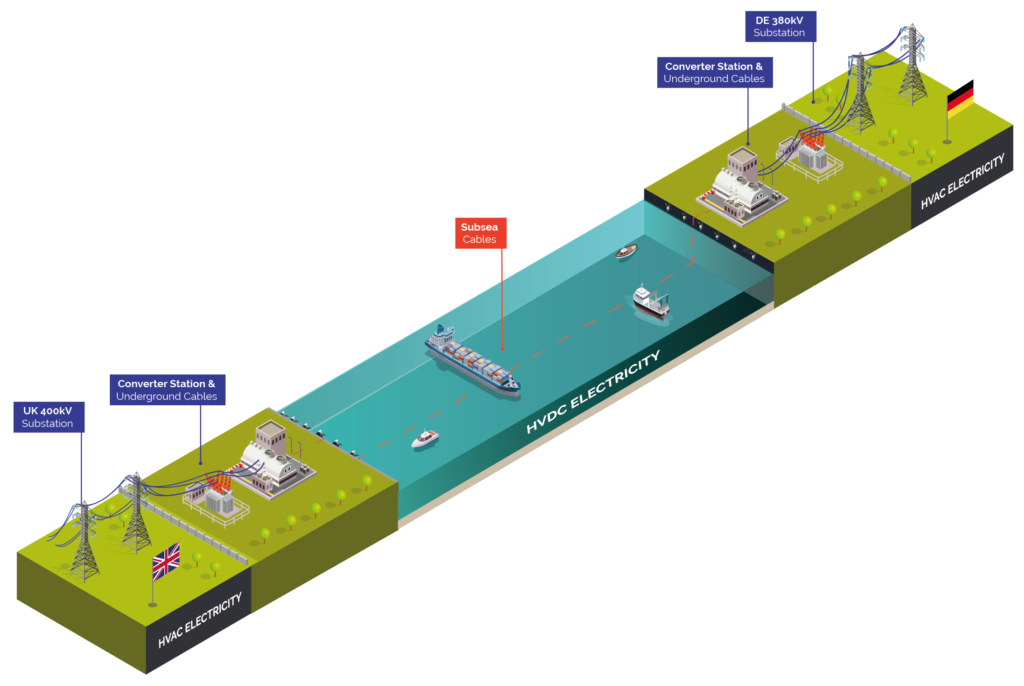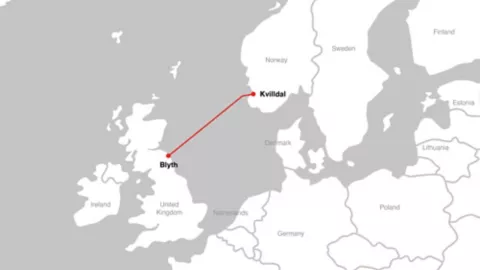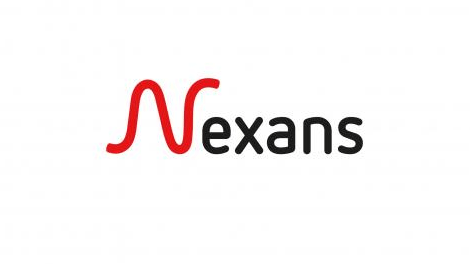Nexans – Nexans awarded its largest agreement in history to support energy transition in Europe with TenneT
 Nexans has been awarded a frame agreement by TenneT, the Transmission System Operator (TSO) for the Netherlands and a significant part of Germany, for turnkey high voltage direct current projects for offshore wind farms.
Nexans has been awarded a frame agreement by TenneT, the Transmission System Operator (TSO) for the Netherlands and a significant part of Germany, for turnkey high voltage direct current projects for offshore wind farms.
Under this frame, Nexans will be responsible for three grid projects, connecting the future offshore wind farms BalWin 3, LanWin 4, LanWin 2, in the German North Sea to main land. The initial value is 1.7bn EUR, with major subcontracted works to be added once the project-specific call-offs are signed.
Nexans will be responsible for the full Engineering, Procurement, Construction and Installation – including civil works (EPCI) of over 2,160 km of subsea and land cables.
In 2022, Nexans made a major step forward with the successful development and testing of the first 525 kV DC cable with key features to enable a substantial increase in transmission capacity. The awarded projects are the first in which the Nexans group is deploying its breakthrough 525 kV offshore cable technology, specifically designed to support the energy transition, that will provide a total of 6 GW of energy from the North Sea to Germany The subsea cables will be manufactured at Nexans’ flagship factory in Halden, Norway.
After the successful completion of the DolWin 6 project and the award of the BorWin 6 project in 2022, the frame agreement continues Nexans’ long-term partnership with TenneT, contributing to the acceleration of Germany’s energy transition. It confirms that Nexans is a reliable partner to support the energy transition and reduce net GHG emissions to meet the carbon neutrality targets set at COP21. These projects will further increase energy security in Europe; they will be operational between 2029 and 2031
” The uncertainty on the energy supply has again underlined the need to invest in offshore grids throughout Europe. This can only happen by creating strong and long term partnerships between suppliers and transmission system operators. The frame agreement developed by TenneT is the perfect answer to those challenges, and is consistent with Nexans’ risk reward model. Nexans is proud to be involved in the ground-breaking developments and delighted to be trusted by TenneT. Our expertise in this field has allowed us to be at the forefront of the energy transition via offshore wind globally. ”
Vincent Dessale, COO and Senior Executive Vice President of Nexans
Nexans’ commitment to sustainability, focus on electrification, development of innovative technologies dedicated to HVDC projects, and investments in new production capacity, vessels and subsea cable protection tools, position the Group as a major player of the energy transition.
” After recent awarding of the first five cable connections and the announcement of the suppliers for the sea- and land-based converter stations, we are again very proud to announce the partners for the multi-year agreement to produce and install the cables for these crucial and innovative grid connection systems for the energy transition. ”
Tim Meyerjürgens, COO TenneT
Source
Nexans
EMR Analysis
More information on Nexans: See the full profile on EMR Executive Services
More information on Christopher Guérin (CEO, Nexans): See the full profile on EMR Executive Services
More information on Vincent Dessale (Chief Operating Officer and Senior Executive Vice President in charge of Building & Territories Northern Business Group, Nexans): See the full profile on EMR Executive Services
More information on TenneT: https://www.tennet.eu + TenneT is a leading European grid operator. Committed to providing a secure and reliable supply of electricity 24 hours a day, 365 days a year, while helping to drive the energy transition in our pursuit of a brighter energy future – more sustainable, reliable and affordable than ever before. Lighting the way ahead together
Next time you turn on the lights, take a moment to think about where that power comes from. In the Netherlands and Germany, it was very likely brought to you by us, TenneT. We own and operate over 25,000 kilometres of high-voltage lines and cables.
As the Transmission System Operator (TSO) for the Netherlands, and a significant part of Germany, TenneT owns and operates over 24,500 kilometres of high-voltage lines and cables. We deliver electricity to 42 million domestic and business users, safely and reliably, 24 hours a day and 365 days a year. With over 6,600 employees in two countries, we are driven by our mission to ensure the lights stay on and that power is available, at the flick of a switch, whenever and wherever you need it.
More information on Manon van Beek (CEO, TenneT): https://www.tennet.eu/about-tennet/our-organisation/executive-board + https://www.linkedin.com/in/manonjjvanbeek/
More information on Tim Meyerjürgens (Chief Operations Officer, TenneT): https://www.tennet.eu/company/profile/executive-board/ + https://www.linkedin.com/in/timmeyerj%C3%BCrgens/
EMR Additional Notes:
- Transmission System Operator (TSO):
- A Transmission System Operator (TSO) is an entity entrusted with transporting energy in the form of natural gas or electrical power on a national or regional level, using fixed infrastructure. The term is defined by the European Commission.
- Low Voltage (LV):
- The International Electrotechnical Commission (IEC) defines supply system low voltage as voltage in the range 50–1000 V AC or 120–1500 V DC.
- Medium Voltage (MV):
- Medium-voltage circuit breakers rated between 1 and 35/72 kV.
- High Voltage (HV):
- The International Electrotechnical Commission define high voltage as above 1000 V for alternating current, and at least 1500 V for direct current.
- Super High-Voltage:
- Is >300kV.
- Ultra High-Voltage:
- Is >1.000kV.
- AC (Alternating Current) & DC (Direct Current):
- Direct current (DC) is an electric current that is uni-directional, so the flow of charge is always in the same direction. As opposed to alternating current, the direction and amperage of direct currents do not change. It is used in many household electronics and in all devices that use batteries.
- Direct current has many uses, from the charging of batteries to large power supplies for electronic systems, motors, and more. Very large quantities of electrical energy provided via direct-current are used in smelting of aluminum and other electrochemical processes.
- in contrast to AC power, DC power is entirely made up of active power, meaning that there are almost no losses due to the capacitance of wires when DC power travels long distances. In fact, high voltage AC transmission systems have losses of 7% to 15% with aboveground transmission.
- Alternating Current is used in homes as Direct current can not be easily stepped up or stepped down with the help of transformers whereas alternating current can easily be converted from low voltage to high voltage or vice-versa with the help of transformers.
- Grid, Microgrids and DERs:
- The power grid is a network for delivering electricity to consumers. The power grid includes generator stations, transmission lines and towers, and individual consumer distribution lines.
- The grid constantly balances the supply and demand for the energy that powers everything from industry to household appliances.
- Electric grids perform three major functions: power generation, transmission, and distribution.
- A microgrid is a small-scale power grid that can operate independently or collaboratively with other small power grids. The practice of using microgrids is known as distributed, dispersed, decentralized, district or embedded energy production.
- Smart Grid is any electrical grid + IT at all levels . Micro Grid is a group of interconnected loads and DERs (Distributed energy resources) within a clearly defined electrical and geographical boundaries witch acts as a single controllable entity with respect to the main grid.
- Distributed energy resources (DERs) are small-scale electricity supply (typically in the range of 3 kW to 50 MW) or demand resources that are interconnected to the electric grid. They are power generation resources and are usually located close to load centers, and can be used individually or in aggregate to provide value to the grid.
- Common examples of DERs include rooftop solar PV units, natural gas turbines, microturbines, wind turbines, biomass generators, fuel cells, tri-generation units, battery storage, electric vehicles (EV) and EV chargers, and demand response applications.
- Engineering, Procurement, Construction and Installation (EPCI):
- Also referred to as an engineering, procurement, construction and installation contract, this is a contract under which a principal engages a contractor to design, build, deliver and install the asset in order for it to be operational.
- EPCI contracts are often used for large-scale mining infrastructure such as mineral processing plants.
- EPCI contracts are complex because they encompass the design, detailed engineering and construction of infrastructure, including the supply of materials and services (for example, testing and installation) to ensure the smooth operation of the infrastructure.
- Under an EPCI contract, the contractor may perform all the services itself; however, EPCI contracts usually give the contractor a right to subcontract part of the work.
- However, the contractor bears the project risk because most EPCI contracts are for a fixed price (irrespective of subcontractor agreements) and based on a schedule mutually agreed in the EPCI contract. The contract price paid by the principal to the contractor is usually paid in stages on the completion of certain project milestones.
- The Paris Agreement (COP 21):
- The Paris Agreement is a legally binding international treaty on climate change under UNFCC. It was adopted by 196 Parties at COP 21 in Paris, on 12 December 2015 and entered into force on 4 November 2016.
- Its goal is to limit global warming to well below 2, preferably to 1.5 degrees Celsius, compared to pre-industrial levels.
- To achieve this long-term temperature goal, countries aim to reach global peaking of greenhouse gas emissions as soon as possible to achieve a climate neutral world by mid-century.
- The Paris Agreement is a landmark in the multilateral climate change process because, for the first time, a binding agreement brings all nations into a common cause to undertake ambitious efforts to combat climate change and adapt to its effects.
- The Paris Agreement is a legally binding international treaty on climate change under UNFCC. It was adopted by 196 Parties at COP 21 in Paris, on 12 December 2015 and entered into force on 4 November 2016.
- HVDC Light:
- HVDC Light is the successful and environmentally-friendly way to design a power transmission system for a submarine cable, an underground cable, using over head lines or as a back-to-back transmission. HVDC Light is HVDC technology based on voltage source converters (VSCs).
- HVDC Light is designed to transmit power underground and underwater, also over long distances. It offers numerous environmental benefits, including “invisible” power lines, neutral electromagnetic fields, oil-free cables and compact converter stations.
- As its name implies, HVDC Light is a dc transmission technology. However, it is different from the classic HVDC technology used in a large number of transmission schemes. Classic HVDC technology is mostly used for large point-to-point transmissions, often over vast distances across land or under water. It requires fast communications channels between the two stations, and there must be large rotating units – generators or synchronous condensers – present in the AC networks at both ends of the transmission. HVDC Light consists of only two elements: a converter station and a pair of ground cables. The converters are voltage source converters, VSC’s. The output from the VSC’s is determined by the control system, which does not require any communications links between the different converter stations. Also, they don’t need to rely on the AC network’s ability to keep the voltage and frequency stable. These feature make it possible to connect the converters to the points bests suited for the AC system as a whole.
- HVDC (High-Voltage Direct Current):
- Key enabler for a carbon-neutral energy system. It is highly efficient for transmitting large amounts of electricity over long distances, integration of renewables and interconnecting grids, opening up for new sustainable transmission solutions.
- HVDC Links:
- The first successful HVDC experimental long distance line (37 miles) was made at Munich, Germany in 1882 by Oskar Von Miller and fellow engineers.
- HVDC allows power transmission between AC transmission systems that are not synchronized. Since the power flow through an HVDC link can be controlled independently of the phase angle between source and load, it can stabilize a network against disturbances due to rapid changes in power.
- An HVDC line has considerably lower losses compared to HVAC over longer distances.

- Neu Connect (the first power interconnection between Great Britain and Germany): https://neuconnect-interconnector.com +
- The NeuConnect Interconnector will create the first direct power link between Germany and Great Britain, connecting two of Europe’s largest energy markets for the first time. Around 720km of land and subsea cables will form an ‘invisible highway’ allowing up to 1.4GW of electricity to move in either direction, enough to power up to 1.5 million homes over the life of the project.

- The Tyrrhenian Link: https://www.terna.it/en/projects/public-engagement/Tyrrhenian-link +
- Connecting Sicily with Sardinia and the Italian peninsula via a double underwater cable: a new electricity corridor at the centre of the Mediterranean; the Tyrrhenian Link. At 950 kilometres long and with a capacity of 1000 MW, this is an infrastructure initiative of international significance, another step towards a more sustainable energy future. The link will improve electricity exchange capacity, facilitate the development of renewable energy sources, and the reliability of the grid.
- The overall project involves two sections: EAST from Sicily to Campania and WEST from Sicily to Sardinia.
- The East section is 480 kilometres long and connects the Fiumetorto landing point, in the municipality of Termini Imerese in Sicily, with the landing point in Torre Tuscia Magazzeno, near Battipaglia in Campania.
- The WEST section is approximately 470 kilometres long and connects the Fiumetorto landing point to the one in Terra Mala, in Sardinia.

- The Viking Link: https://viking-link.com +
- World’s longest power interconnection. the Viking Link is a 1400 MW high voltage direct current (DC) electricity link between the British and Danish transmission systems connecting at Bicker Fen substation in Lincolnshire and Revising substation in southern Jutland, Denmark.

- The North Sea Link: https://northsealink.com/ + North Sea Link is a 720 kilometre subsea interconnector linking the electricity systems of the UK and Norway. The 1400 megawatt interconnector stretches from Blyth in the UK, across the North Sea, to Kvilldal in Norway.

- The Hertel–New York interconnection line: https://www.hydroquebec.com/projects/hertel-new-york-interconnection/ + The Hertel–New York interconnection line project aims to supply clean, renewable energy to New York City. In Québec, the project involves the construction of a line that will span 57.7 km (56.1 km underground and 1.6 km underwater). This 400-kV direct current line will connect Hertel substation in La Prairie to an interconnection point in the Rivière Richelieu at the Canada–United States border.


